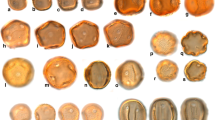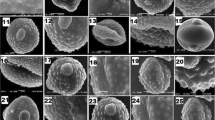Abstract
The pollen morphology from 67 collections representing 52 species of Mutisia was analyzed by means of light, scanning electron and transmission electron microscopy. Pollen of Mutisia is comparable to that of the more widespread type found in Mutisiinae. The pollen grains of the genus are characterized by the spheroidal-subprolate to prolate shape, large size, tricolporate aperture, with mesoaperture, exine Mutisia type, with sculpturing microechinate to rugulate or microechinate-rugulate. This basic pollen type is very variable in size, endoaperture shape, and exine thickness of the pollen grains. A new type of arrangement of columellae was observed in pollen of Mutisia section Mutisia (e.g., M. stuebelli, M. microphylla, and M. sodiroi). It is suggested that it might have harmomegathic significance. The pollen morphology and polymorphism are discussed with regard to functional mechanisms and possible evolutionary significance.









Similar content being viewed by others
References
Blackmore S, Barnes SH (1986) Harmomegathic mechanisms in pollen grains. In: Blackmore S, Ferguson IK (eds) Pollen and spores: form and function. Academic Press, London, pp 137–149
Borsch T, Wilde V (2000) Pollen variability within species, populations, and individuals, with particular reference to Nelumbo. In: Harley MM, Morton CM, Blackmore S (eds) Pollen and spores: morphology and biology. Royal Botanic Gardens, Kew, pp 285–299
Bronckers F (1963) Variations polliniques dans une série d’autopolyploides artificiels d’Arabidopsis thaliana (L.) Heynh. Pollen et Spores 5:233–238
Cabrera AL (1965) Revisión del género Mutisia (Compositae). Opera Lilloana 13:5–227
Cabrera AL, Willink A (1980) Biogeografía de América Latina. O.E.A. Serie de Biología, Monografía 13, Washington, DC
Diez MJ, Mejías JA, Moreno-Socías E (1999) Pollen morphology of Sonchus and related genera, and a general discussion. Plant Syst Evol 214:91–102
El-Ghazali GEB (1990) An illustrated key to endoaperture morphology. Rev Palaeobot Palynol 63:227–231
Erdtman G (1960) The acetolysis method. A revised description. Svenk Bot Tidskr 39:561–564
Erdtman G (1969) Handbook of palynology. An introduction to the study of pollen grains and spores. Copenhagen, Munksgaard
Fisher TR, Wells JR (1962) Heteromorphic pollen grains in Polymnia. Rhodora 64:336–340
Furness CA, Magallón S, Rudall PJ (2007) Evolution of endoapertures in early-divergent eudicots, with particular reference to pollen morphology in Sabiaceae. Plant Syst Evol 263:77–92
Halbritter H, Hesse M (2004) Principal modes of infoldings in tricolp(or)ate angiosperm pollen. Grana 43:1–14
Hansen HV (1991) SEM-studies and general comments on pollen in tribe Mutisieae (Compositae) sensu Cabrera. Nord J Bot 10:607–623
Holmgren PK, Holmgren NH, Barnett LC (1990) Index herbariorum, part I. The herbaria of the world, 8th edn. Bronx, New York Botanical Garden
Katinas L, Pruski J, Sancho G, Tellería MC (2008) The subfamily Mutisioideae (Asteraceae). Bot Rev 74:469–716
King RM, Robinson H (1967) Multiple pollen forms in two species of the genus Stevia (Compositae). Sida 3:165–169
King RM, Robinson H (1968) Studies in the Compositae-Eupatorieae VIII. Observations on the microstructure of Stevia. Sida 3:257–269
Mejías JA, Diez MJ (1993) Palynological and cytological observations in spanish Sonchus (Asteraceae). Grana 32:343–347
Mignot A, Hoss C, Dajoz I, Leuret C, Henry JP, Dreuillaux JM, Heberle-Bors E, Till-Bottraud I (1994) Pollen aperture polymorphism in the angiosperms: importance, possible causes and consequences. Acta Bot Gallica 141:109–122
Nadot S, Ballard Jr, Creach B, Dajoz I (2000) The evolution of pollen heteromorphism in Viola: a phylogenetic approach. Plant Syst Evol 223:155–171
Parra O, Marticorena C (1972) Granos de polen de plantas chilenas, II. Compositae-Mutisieae. Chile. Gayana Bot 21:1–107
Punt WS, Hoen PP, Blackmore S, Nilsson S, Le Thomas A (2007) Glossary of pollen and spore terminology. Rev Palaeobot Palynol 143:1–81
Sazima M, Machado ICS (1983) Biologia floral de Mutisia coccinia St. Hil. (Asteraceae). Rev Brasil Bot 6:103–108
Stainier F, Coppens d’ Eeckenbrugge G, Gobbe J (1989) La morphologie pollinique chez des plants autopolyploides de Cichorium intybus L. Pollen Spores 31:187–202
Stix E (1960) Pollenmorphologische Untersuchungen an Compositen. Grana Palyn 2:41–104
Tellería MC (2008) Taxonomic significance of pollen types in the Guyana Highland-centred genera (Asteraceae, Mutisioideae). Bot J Linnean Soc 156:327–340
Tellería MC, Forcone A (2000) El polen de las mieles del valle de Río Negro, provincia fitogeográfica del monte (Argentina). Darwiniana 38:273–277
Tellería MC, Katinas L (2004) A comparative palynologic study of Chaetanthera (Asteraceae, Mutisieae) and allied genera. Syst Bot 29:752–773
Tellería MC, Urtubey E, Katinas L (2003) Proustia and Lophopappus (Asteraceae, Mutisieae): generic and subtribal relationships based on pollen morphology. Rev Palaeobot Palynol 123:237–246
Torres C (2000) Pollen size evolution: correlation between pollen volume and pistil length in Asteraceae. Sex Plant Reprod 12:365–370
Vélez MI, Hooghiemstra H, Metcalfe S, Martínez I, Mommersteeg H (2003) Pollen- and diatom based environmental history since the Last Glacial Maximum from the Andean core Fúquene-7, Colombia. J Quat Sci 18:17–30
Wang J, Cruzan MB (1998) Interspecific mating in the Piriqueta caroliniana (Turneraceae) complex: effects of pollen load, size and composition. Amer J Bot 85:1172–1179
Wodehouse RP (1929) Pollen grains in the identification and classification of plants IV. The Mutisieae. Amer J Bot 16:297–313
Zao Z, Skvarla JJ, Jansen RK (2006) Mutisieae (Asteraceae) pollen ultrastructure atlas. Lundellia 9:51–76
Acknowledgements
We are grateful to Gloria Daners for valuable comments on the manuscript. We are also grateful to curators of several herbaria for loans of specimens and to Pablo Pérez for helping with LM photographs. Support was provided by Agencia Nacional de Promoción Científica y Tecnológica, Argentina (PICT No. 26289), and Consejo Nacional de Investigaciones Científicas y Técnicas (CONICET), Argentina (PIP 5294 and 5604).
Author information
Authors and Affiliations
Corresponding author
Appendix
Appendix
Voucher material examined for the study of pollen. Superscripts refer to Table 1.
Fruticosa section. M. comptoniaefolia Rusby: Krach 7178 (SI). M. homoeantha Wedd.: Meyer 17565 (LP). M. ledifolia Decaisne: Cabrera 9438 (LP).
Guariruma section. M. alata Hieron.: López et al. 6719 (LP). M. andersonii Sodiro: Scolnik 1532 (LP). M. arequipensis Cabrera: Treacy 840, 829 (WIS). M. cochabambensis Hieron.: 1Zamaloa 2033 (LP); 2Cañigueral 11 (LP). M. decurrens Cav.: 3Grüner 132 (LP); 4Soriano 4294 (LP). M. hamata Reiche: Cabrera et al. 22495 (LP). M. lanigera Wedd.: Riccardi and Marticorena 25468 (LP). M. mandoniana Wedd.: Sodiro 4549 (SI). M. retrorsa Cav.: Vignati 420 (LP). M. saltensis Cabrera: Cabrera et al. 25519 (LP). M. sinuata Cav.: 5Fabris and Marchionni 2344 (LP); 6Fabris 1221 (LP). M. spectabilis Phil.: Jiles 1834 (LP). M. subspinosa Cav.: Ruiz Leal 1051 (LP); Villavicencio, O’Donell 1331 (LP).
Holophyllum Section. M. acerosa Poepp.: Cabrera 3463 (LP). M. friesiana Cabrera: Cabrera et al. 22501 (LP). M. linearifolia Cav.: Marticorena and Matthei 947 (LP). M. mathewsii var. anomala Cabrera: Macbride and Featherstone 907 (LP). M. subulata R. et P.: 7Jiles 4189, 8Jiles 2586 (LP).
Isantha Section. M. kurtzii R. E. Fries: 9Fabris et al. 4082 (LP); 10Cabrera 9001 (LP).
M. linifolia Hook.: Dawson and Pujals 1611 (LP). M. orbignyana Wedd.: 11Isern 394 (LP); 12Meyer et al. 20888 (LP).
Mutisia Section. M. acuminata var. paucijuga (Gris.) Cabrera: Cabrera et al. 13894 (LP). M. campanulata Less.: Hatschbach 4058 (LP). M. clematis L.: Fosberg 22294 (LP). M. coccinea St. Hil.: Krapovickas et al. 22993 (LP). M. grandiflora Humb. et Bonpl.: 13Acosta Solís 5442 (F); 14Cuatrecasas 20917 (F). M. hamata Reiche: Cabrera et al. 22495 (LP). M. intermedia Hieron.: Sodiro (BAF). M. lanata R. et P.: 15Scolnik and Luti 519 (LP); 16Weddell 2314 (LP). M. lehmannii Hieron: 17Jaramillo 5415 (F); 18Dorr and Valdespino 6382 (F). M. microphylla Willd. ex DC.: 19Firmin 524 (F); 20Romoleroux 297 (F). M. pulcherrima Muschl.: Sagástegui 7469 (LP). M. retrorsa Cav.: Vignati 420 (LP). M. rimbachii Sodiro ex Harris: Villacrés 234 (F). M. sodiroi Hieron.: 21Sodiro (BAF); 22Fosberg 21188 (F). M. speciosa Ait.: 23Grüner 1077 (LP); 24Rodríguez 1265 (LP). M. spectabilis Phil.: Jiles 1834 (LP). M. stuebelii Hieron.: Cuatrecasas 19156 (FM). M. subulata R. et P.: Jiles 2586 (LP). M. venusta Blake: Vargas 4420 (LP). M. vicia Koster: without leg. no. 2256 (LP). M. wurdackii Cabrera: López et al. 4303 (LP).
Ovata Section. M. brachyantha Phil.: Wederman 541 (LP). M. cana Poepp. et Endl.: Jiles 2710. M. ilicifolia Phil. var. decandolleana (Phil.) Cabrera: Pisano et al. 1665 (LP), Jiles 1871 (LP). M. involucrata Phil.: Barros 3804 (LP). M. latifolia D. Don: Jiles 3139 (LP). M. macrophylla Phil.: 25Barros 7552; 26Barros 1772 (LP). M. oligodon Poepp. et Endl.: 27Cabrera 6090 (LP); 28Ledezma 650 (LP). M. spinosa Ruiz et Pav.: 29Landrum 4378 (LP); 30Hollermayer 725 (LP).
Rights and permissions
About this article
Cite this article
Tellería, M.C., Katinas, L. New insights into the pollen morphology of the genus Mutisia (Asteraceae, Mutisieae). Plant Syst Evol 280, 229–241 (2009). https://doi.org/10.1007/s00606-009-0185-5
Received:
Accepted:
Published:
Issue Date:
DOI: https://doi.org/10.1007/s00606-009-0185-5




